It had been 9:00pm or so by the time I'd finally climbed up into the tent to head to bed, and I'd hoped that my second connection of the trip would show up as I slept - the plan, to spend the following day (today) together exploring a few interesting areas around Eureka Valley.
Hoping to make that connection easier, I'd left my APRS on in the truck, and I'd also left a couple paper plates attached to creosote bushes along the road in hopes that they'd be spotted by the amazingly bright lights that I knew this fellow explorer would be utilizing during a late-night arrival.
Around 10:30pm, I was awoken by the sound of a reving 3.4L V6 making itself known along Death Valley Road. As I glanced out the tent door, I knew the plates had been missed, and I quickly flashed my flashlight at the passing truck. Nothing!
A quick call on the Ham radio alerted my companions to my presence, and they quickly turned around and pulled into camp - two or three hours earlier than I'd expected them to arrive. Quick handshakes and hugs were shared, but we left the majority of our greetings for the morning - for now, we were all tired and climbed into bed.

Over breakfast the next morning, Ben @m3bassman mentioned that he had seen the plates, but associated them with backwoods Idaho hillbillies - of which he didn't know I was one - so just kept going! 
We chatted for a good hour as the morning sun warmed our bones and then decided we had better get moving - we had a full day of exploration along and eastern arm of the Inyo Mountains, where we hoped to see a series of talc mines and overlooks as we travelled some of the parks roughest and least-traveled trails.
Our first series of mines would be the Victor Mines - three of which were perched at various points along the the hillside on the Eureka Valley side of the range. As we started out of camp, I was in the lead - eventually pulling out a good distance ahead of Ben and Kirsten, prompting a, "You feeling OK this morning?" from Ben, who is used to my traditionally slow pace!

Ultimately we made our way through several rough patches and washes to the Victor No. 1 mine - the road clearly one that hadn't seen vehicular traffic for quite some time.


As we reached a small platform at the end, a well-hidden mine shaft opening with a door that'd seen better days, popped into view. We made our way in 50 feet or so - flashlights in hand - before deciding we'd had enough and heading back to the relative safety of the entrance.

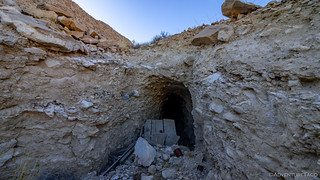
A little further on, some old ruins - perhaps a loading platform - sat below another, seemingly more secure tunnel and we couldn't help but enter this one to explore as well.


The ceilings here were significantly taller than the first shaft, and the entire thing had been carved into hard stone rather than the gravels of an alluvial fan - so we were a bit bolder in our exploration. At one point this shaft opened into a large room from which several shafts split in various directions, and then we reach the end of the primary dig - some hundred feet or so inside the mountain.
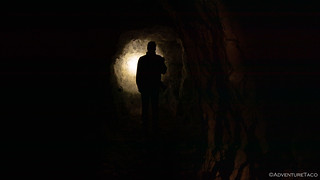
Back on the road, our next planned stops were the Victor Consolidated Mine and Victor No. 8. The roads to these workings were in even worse shape, and less than half way to each of them, we were stopped by complete disappearance of the access roads!

Bummed - since we could see the workings on the hillside, but knew we didn't have time in the day to add two longish hikes - we tucked tail and moved on, as I made a note to return on a future trip for a full investigation.

Now, the reason we'd started with these three Victor Mines was that they were on the north end of a loop that would take us around to the Harlis and Broady Mine on a road that we'd heard was itself a big part of the adventure. To save time, we decided that we'd backtrack a bit and make our way into the mine from the south - so we headed back to Death Valley road, losing the trail only once along the way and having to improvise a bit.

This rock looks small here, but caused some contemplation on Ben's part as he navigated its sharp edges.
Once we reached the entrance to the Harlis and Broady Mine Road, we knew that we were going to be lucky to reach the mine. Already at 5515 feet and with snow on the road, we still had several hundred feet to climb before reaching a ridge that led to the mine.

Hopeful, we set off. Before long, we discovered a very cool GMC pickup that had been sitting in this wash for several decades at least. While many of the parts were missing - perhaps borrowed for working equipment or looted by visitors over the years - its body was in amazingly good shape, and we enjoyed ourselves as we poked around the remains.


I think I see the problem here. The engine is missing.

Unfortunately, it wasn't much further up the road before we were stopped in our tracks. Having gotten out to walk due to deepening snow, it turned out that while we likely could have navigated the crunch white stuff, there was what looked like a 700-800 lbs boulder a little further on that would have been interesting for Ben and I to move. Not knowing what remained beyond that, we opted to turn back and move on - now a mere 1-for-4 on our mine attempts for the morning! At least the views of North Eureka Valley here were reasonably great.
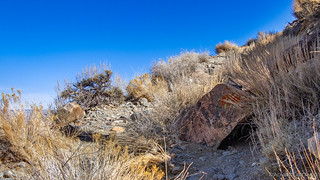

Part of the reason we'd been so quick to move on was that our next destination - yes, another talc mine, on another crazy road - was slated to be one of the best. Called the ▮▮▮▮▮▮▮▮▮▮▮▮▮▮▮ Mine, its elevation was even higher in the Inyos but all we could do was hope that the nature had been nicer to the road than our previous attempts. And with that, we started up.

As we ascended, I quickly realized that the road conditions were similar - if not slightly worse - to the conditions we'd experienced on the Harlis and Broady Mine Road. I called back to Ben and Kirsten over the CB that they should wait at a good spot to turn around while I pushed forward, so that we wouldn't both have to back down the narrow, snowy, shelf road if I ran into another impassable section.
It was a good thing, too, because there were several rock-falls on this road as well - some of them quite large.

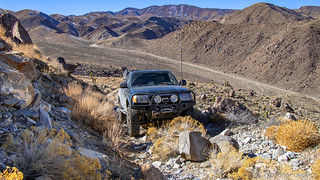
Luckily, in each case, I was able to roll, push, and slide the rocks just far enough out of the way in order to squeeze a narrow, 1st gen Tacoma through - though not without a bit of slider use in a couple situations - and up towards our final destination.
Each time, as I'd find another turnaround spot, I'd call Ben forward, the steep mountains limiting the distances that even our ham radios would communicate. The entire road was only 1.7 miles long, but it took us nearly 45 minutes to make it to the end - parts of the drive a white-knuckle experience, at least for me.
The view however - at the mine camp - was incredible.


Nearly all of Eureka Valley unfolded before us. Everything I'd explored the last few days lay down there, seemingly so easy to achieve - and yet, I knew that vast distances meant they were seldom visited by more than a few. As I waited for my companions to crest the ridge, I soaked in the grand peacefulness of it all, as best I could.
Soon enough, we were all back together again and we set about exploring the mine camp and one of the diggings of the ▮▮▮▮▮▮▮▮▮▮▮▮▮▮▮ Mine. A windy spot here on the ridge, the camp itself has been unable to withstand the passing of time and is mostly just a pile of rubble.
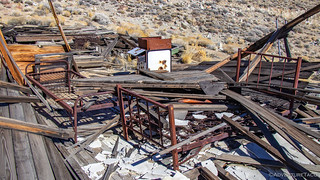
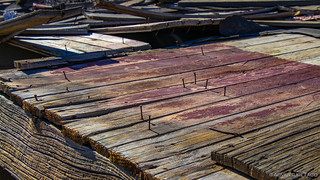
Exposed to decades of freeze-thaw cycles, these nails have been pushed out of the floorboards into which they were originally pounded.
Even more interesting than the mine camp however, was a road that led down the west side of the ridge at a very steep grade. Perhaps once passable by a 4WD vehicle, none of our group wanted to attempt it - for fear that we'd not be able to get back up - but that didn't stop us from hiking down to see the treasures that it held.
Boy, did it hold some beauties. The highlight was a large headframe and loading structure - still reasonably intact - protected from the weather well below the ridge. We spent a good bit of time exploring this structure, along with the cabin that housed the motor that powered the entire thing, it was so interesting.


A second mine shaft cut into the mountain as well, and a small dump road allowed the workers to easily dispose of tailings down the 2000 foot ravine.


Eventually we decided it was time to get going - our lunches waiting for us high above at our trucks, and a full afternoon of adventure still to come - so we pushed our legs up the steep, loose-shale incline, glad we hadn't ventured down with the trucks.

Lunch was a pleasant affair, spent chatting in the shade of our trucks about everything under the sun. It'd been quite some time since I'd been on a trip with Kirsten, and even Ben I hadn't seen since our trip to the Alvord Playa to look for Jessi Combs last tracks, so it was nice to catch up before heading back down the mountain and across the northern end of Eureka Valley.
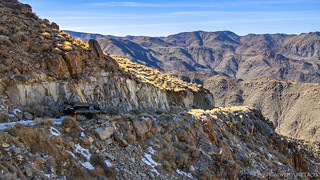
We had one more hike planned for the day, and it was one that I'd been looking forward to since @mrs.turbodb and I were here a few months earlier, Searching for Overlooks. We'd been in a bit of a rush a the time, wanting to scale Eureka Dunes before night fall, so when we'd arrived at Lead Peak, we'd decided we'd skip the steep hike down to the Rebecca No. 2 mine.
Today though was going to be different. As we drove along the ridge, and ultimately found ourselves a nice overlook of the dunes, I hoped the cabin at the bottom - reportedly in great shape - would be worth the effort.



I can say without a doubt that the "road" - which really only about 15% of the hike could be classified as such - was definitely steeper than the one we'd traversed just a few hours earlier on the other side of the valley. A huge landslide had destroyed the majority of it, and so we did our best to pick our way down a 40° slope to the waypoint I'd marked on my phone for the Rebecca No. 2 mine.
Already wondering about our climb back up as we reached the mine, the good news was that it was right where we expected. The bad news was that it wasn't in the condition we were hoping to find it. Clearly, this cabin and mining claim were occupied later than some of the others I've visited in the park, but it was far from one of the "nicer" cabins by today's standard.

The exterior plywood has seen better days, and the inside could definitely use a thorough cleaning - rat and bird droppings covering almost every surface.



We found the cabin log and made a quick entry before starting back up the 1000 feet or so of mountainside that we needed to traverse in the half-mile to our trucks. It was a grueling hike, a good indicator as to why the cabin gets fewer than two visitors each year - the one prior to us being in March 2019.


Picking our way up the rocky slopes, we made steady progress back up to the trucks. I wanted to check out one more thing before we left - the view from the top of Lead Peak - so we all hiked the short trail to the peak and looked out over the valley we'd been high above for most of the day. It's striking to me how different the same place can look from different angles, and under different light. It's comforting really - because it means that even visiting the same place twice and often lead to quite different experiences.
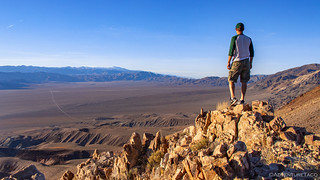
From Lead Peak, we knew it was time to find camp. The sun was getting close to the horizon and we'd had a long day even though we hadn't traveled all that many miles. But, before we headed back down into Eureka Valley where it was a bit warmer than up here in the mountains, we had one more stop to make - at Crater.
An old sulfur mine, Crater is the location of a small ghost town and what I would characterize as Death Valley's most interesting sulfur mine ruins. The landscape here is bleak - the powdery white ground, the result of heavy machinery pulverizing the already dusty talc and salts in the area as they extracted the sulfur from the ore.
In the middle of the mine site, machinery from the most recent refinery sits dormant and rusting - one of the few sulfur retort ruins in the American West. The retort itself has collapsed over the years and is laying on its side, but in its heyday it was loaded with sulfur ore and high pressure steam was injected into it. The steam would melt the sulfur, liquifying it and allowing it to be separated from other rocks. This molten sulfur would be drawn off through an opening at the bottom of the retort and refined sulfur ore can still be found around the old machinery.
Next to the retort, a tumbler still stands tall, its goal to crush the sulfur ore prior to steaming it in the retort, to allow as much sulfur as possible to be melted via the steam injection.

As with many sulfur mines, Crater's end came when a fire broke out. Sulfur dust - an ingredient in gun powder - being highly flammable, this was the fate of many sulfur mines of the day.
Our final stop was at the old three-compartment oven of the Gulch sulfur mine. Used in the 1930s, it is not often that this type of mining equipment stands in such good condition, and of the sulfur history in the area, I find it the most interesting.

With that - and the final rays of light - we high-tailed it back into the valley and found a spot - familiar to me from two nights prior - to camp, at the end of Dry Well Road. It was a good spot for many reasons, not the least of which was the fact that we'd be parting ways the next morning. As my trip had started when Ken @DVExile's was ending, so my trip was ending just and Ben and Kirsten's was starting. I was headed north towards home, they south through Death Valley, the Mojave Preserve, Joshua Tree, and ultimately to Johnson Valley and the King of Hammers. For me, it was interesting to realize how the trip had been a full circle of both new and old connections!
We all enjoyed dinner as we chatted around a Coleman lantern that served as our campfire, talk of the day we'd had together and what was to come for each of us over the course of the year. It was still early by our standards when we all climbed into our respective tents, but none of us were complaining - we'd had a full day and were ready for some sleep!

The Whole Story
Love Death Valley and want to see more adventures there?
You'll love the Death Valley Index.

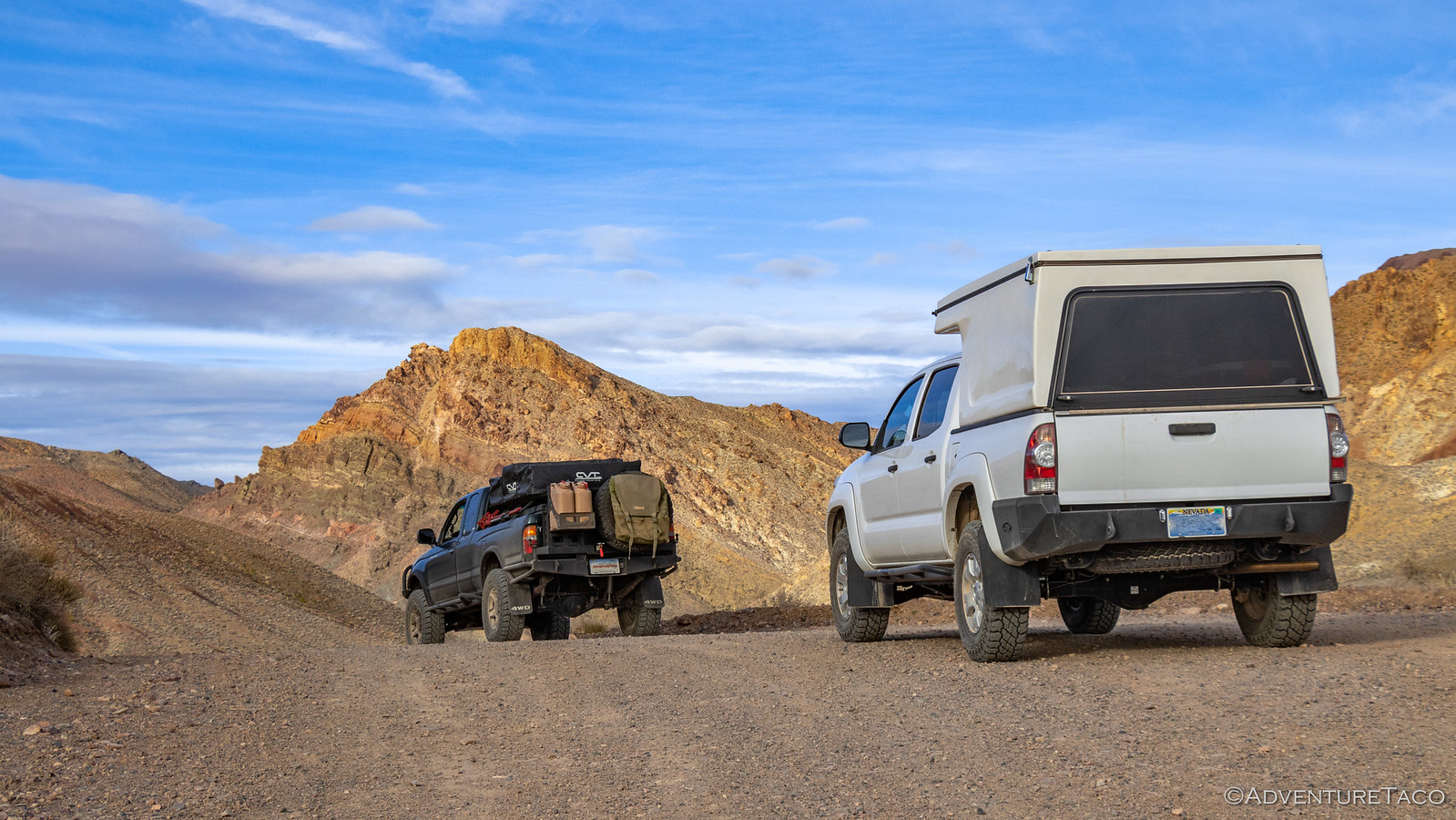
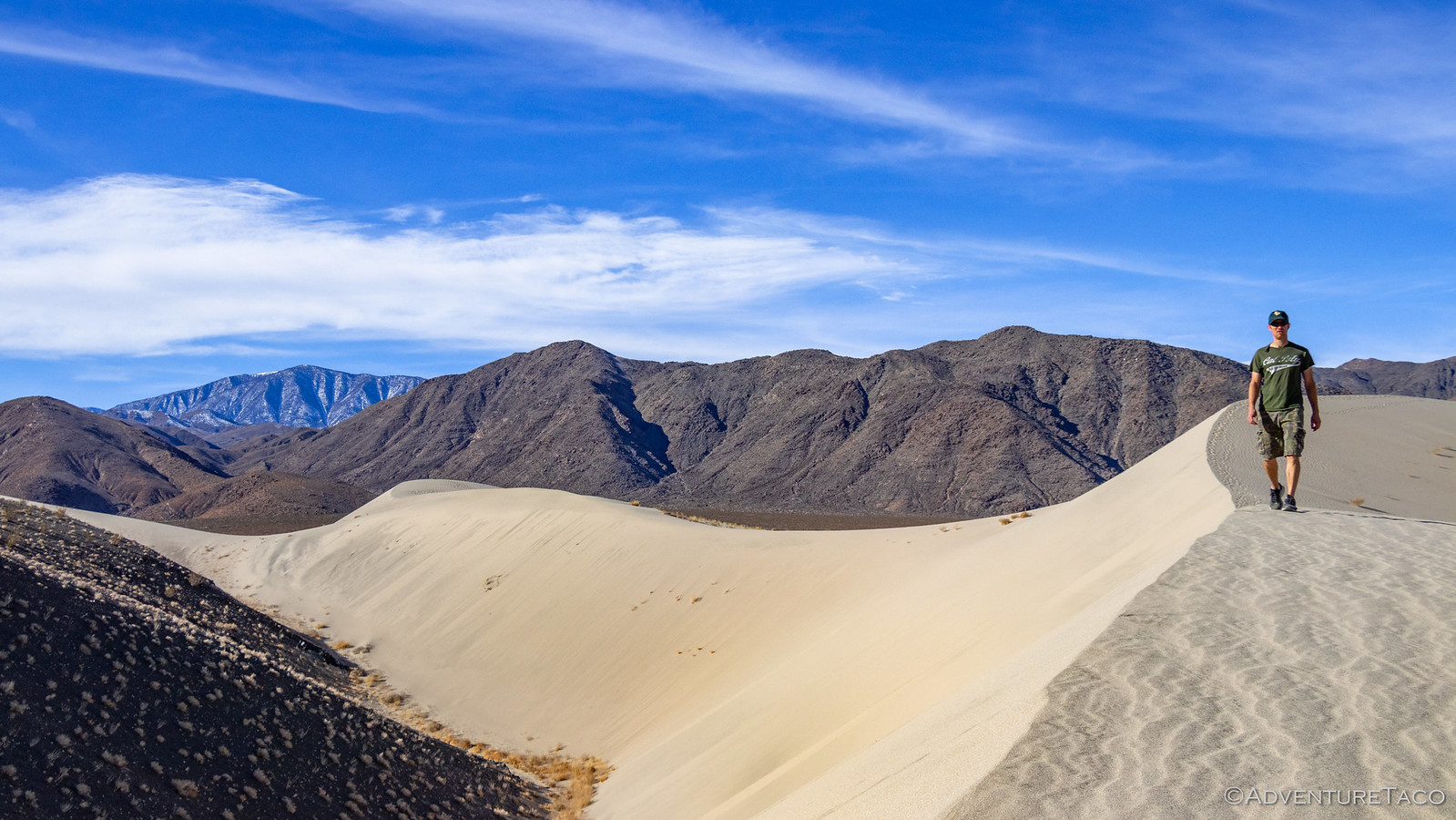

Do the sulfur areas surrounding the old mines - smell sulfur-y?
Very much so. On a hot day it can be overwhelming. Luckily, we've never been there on a hot day! ? ? ?